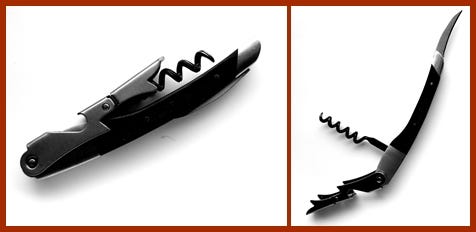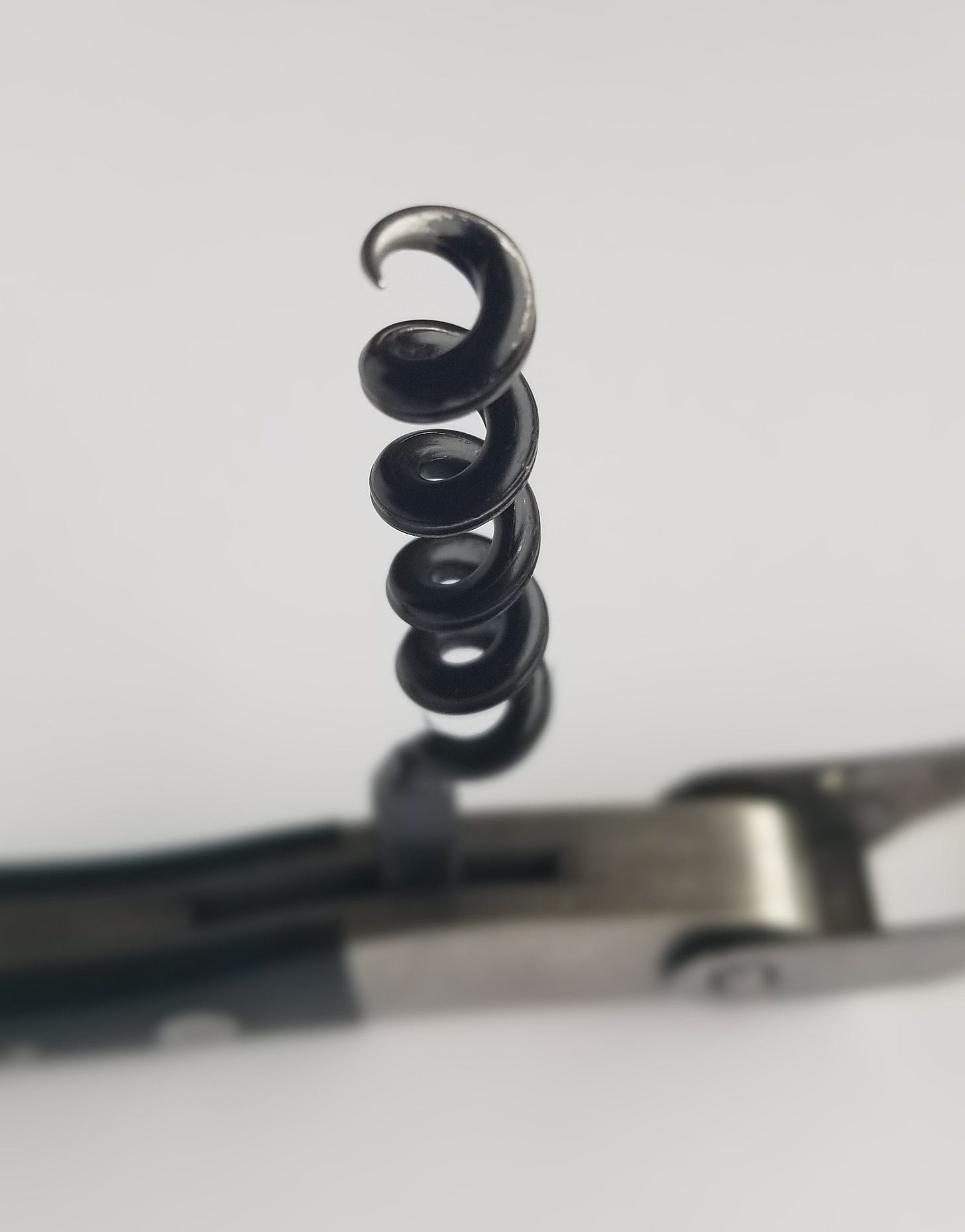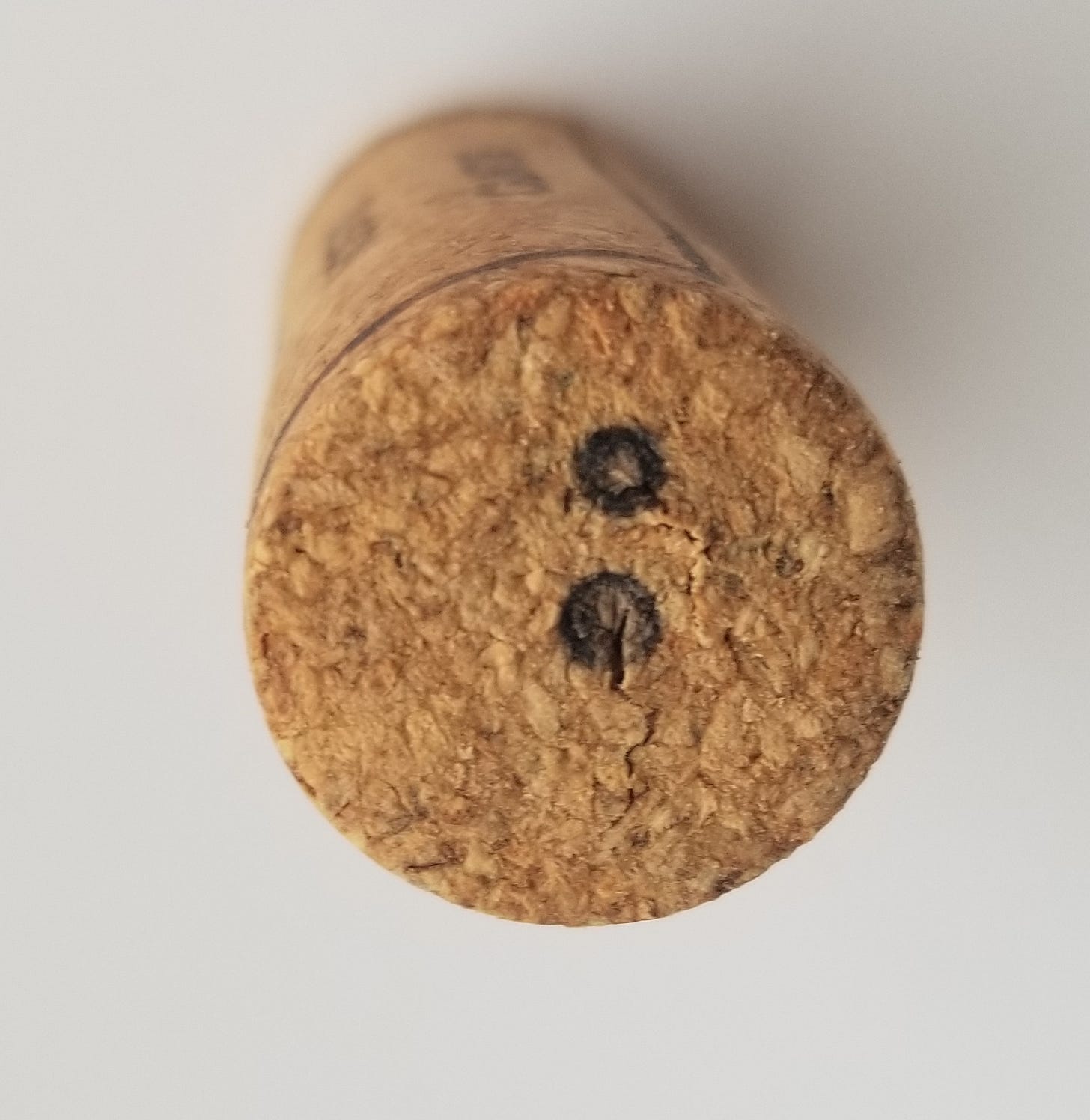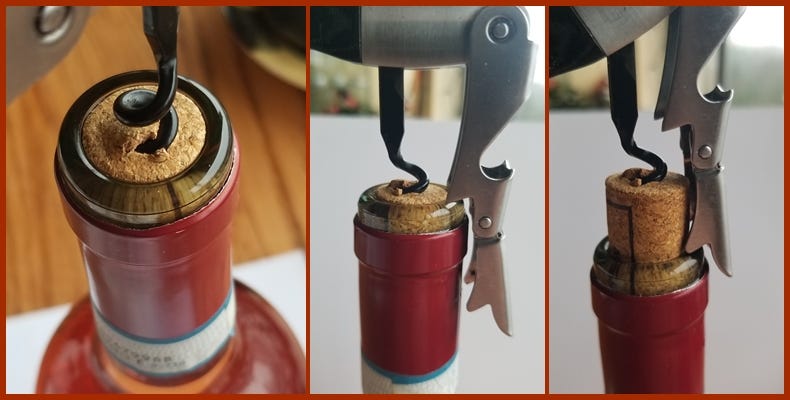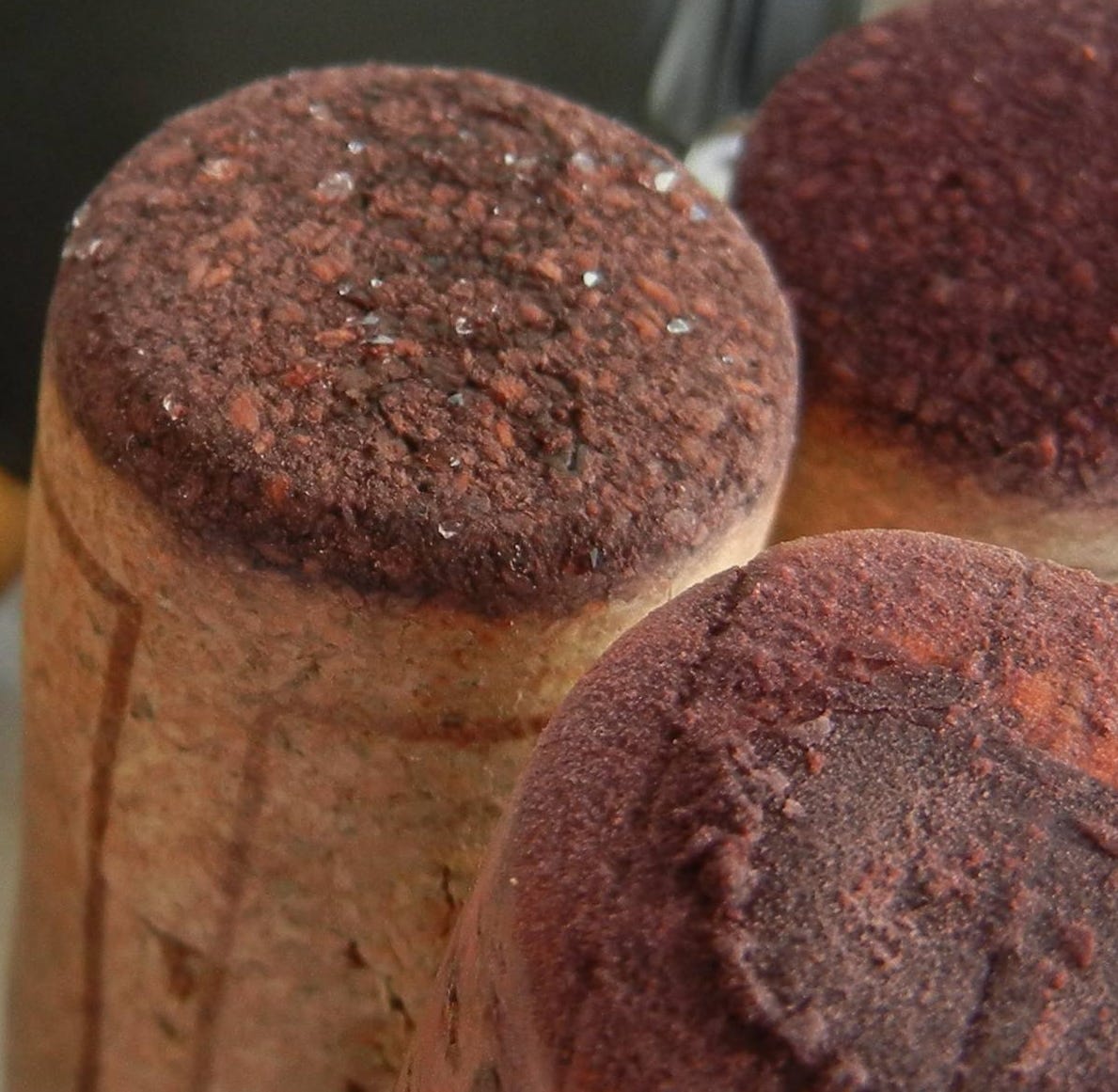Using a "Waiter's Friend" Corkscrew & Dealing With What's Under The Cork
Wine Bargains in B.C. #3 February Deals 1
Pro Wine Tip - Opening Remarks
How To Use a "Waiter's Friend" Corkscrew And Dealing With What You Could Find When The Cork Comes Out...
You can’t learn about without pulling corks so let’s take a bit of a dive into using a simple corkscrew to pull out the cork and also touch on some of the things you might find after you do.
The Knife, the Worm and the Lift
The “waiter’s friend” is that simple folding corkscrew that servers use to open wine for you in restaurants. It fits nicely in a pocket or your kitchen drawer and unfolds like a specialized Swiss Army Knife.
It has three specialized tools
1. knife or foil cutter for removing top of the capsule
2. the worm, a metal spiral that goes into the cork
3. The lift, also known as the fulcrum or lever for lifting the cork up and out from the neck of the bottle.
First you will need to remove the top of the capsule that encloses the top of the bottle to get at the cork itself. The capsule can be made of foil or plastic. Some people take it off entirely but I think that it looks cleaner and more elegant to remove just the top. Open just the knife tool of the corkscrew to do this.
The first choice here is where to make the cut. There is ridge at the top of every wine bottle with a cork. A sommelier is trained to cut below the ridge, often holding and turning both corkscrew and bottle in mid-air until a circular cut is completed. Perhaps when you have opened hundreds of bottles as a professional this is quick, easy and neat but I find it harder to get a clean even cut and it’s more fussy to remove the cut top afterwards. Maybe it’s just me.
I like to cut above the ridge. And since you are at home, instead of having to hold the corkscrew in one hand and the bottle in the other as the Sommelier must do, you can just put the bottle on your counter, apply the knife above the ridge with a little pressure and just turn the bottle until the cut is complete.
The thickness of the capsule can vary quite a lot. More expensive wines have thicker capsules (and often heavier bottles) to convey greater value/luxury. So you may have to go around a few times to cut all the way through. Because the bottle is staying level though, this makes for a very neat cut.
If you are turning the bottle, take care not to place the bottle on a tablecloth, or furniture with a fine finish. The bottom of wine bottles have a ridge around the circumference and would catch the tablecloth or mar a wooden finish. So do this on a working surface like your kitchen counter.
Sometimes in transit, corks get wet and leak slightly. If it hasn’t leaked to the point of drooling out the bottom of the wine capsule, often the wine will still be fine, but it will leave behind a bit of fine, dried material. If you find this or mold when you have removed the top of the capsule, this is the time to wipe it clean with a damp cloth but don’t use soap or other chemicals as this could later get into the wine. If you wait until the wine is open first to clean the top of the bottle, bits can easily get in there.
As The Worm Turns
It’s one of the finer points but where you place the tip of the worm in the cork can be important. It is one of my (many) pet peeves regarding other “how to” wine instructions. They say to place the corkscrew in the middle of the cork but without more information, you can get it a little wrong. Notice that the sharp tip of the worm is not in the exact center of the worm. The exact center of the worm is actually in the middle of the empty column surrounded by the spirals of the worm. So ideally, the real center of the worm should line up with the center of the cork.
Some corks are more difficult to get out so to have the best chance of getting it out without ripping a hole in the middle you need to spread the upward force of the worm equally. I know this is pretty geeky but I am a wine geek and that’s likely part of why you are here, what can I tell you?
In the photo below, the center dot is the middle of the cork and the other dot is where you actually need to place the worm tip, about half way between the center and the circumference in order to line up the center of the worm and the center of the cork. It’s also important to keep the worm perpendicular to the cork. If it goes in at an angle it may go to the side of the neck and make removing the cork more difficult.
Below is the difference that worm tip placement can make when the worm is off to the side instead of centered in the cork. Most of the time it won’t make a big difference in removing the cork and it will come out intact just fine but if the wine is older, the cork has gotten wet or moldy or it is of lesser quality, the worm can shred the cork instead of pulling out when you use the lift. This makes getting the rest of the cork out more difficult, frustrating and means you are likely to end up with bits of cork floating around in your wine (not a big deal but certainly annoying).
Centering the worm properly just helps improve your chances of getting the cork out in one piece.
Okay, let’s open that wine.
Insert the worm in the right place leaving one or two spirals outside the cork. If you bury all the spirals of the worm in the cork, you won’t be able to fit the first lifter on to the edge of the bottle.
Now just grip one hand around both the lifter and the bottle and lift up steadily on the main body of the corkscrew. It should lift the cork out about half way. Now tilt the corkscrew up to place the edge of the second lifter on the edge of the bottle and lift steadily again. That should bring the cork pretty much completely out.
Longer corks might need to come up a little more. To get that little bit extra, you can now bury the last one or two spirals into the cork and lift again. If it is still not out, you can just pull on the whole thing and pop the cork out.
Dealing With What You Could Find When The Cork Comes Out...
Here are four common things, some charming, others unfortunate, that you might find out about the wine once the cork is out.
SO2
SO2 or sulphur dioxide is used in very tiny amounts to stabilize wine and preserve it from the negative effects of oxygen. If you are smelling the wine in the glass, and you find it smells extremely faint or like a recently struck match, it might be the presence of SO2. Happily, this usually blows off in a few minutes and reveals the real wine. Just leave it for a few minutes in a glass to confirm or try decanting the wine and it should vanish.
“Corked Wine”
Also known as cork taint, the wine will smell like a musty attic and/or taste like a wet newspaper. It is caused by the cork (tree bark) coming into contact somewhere in its life with fungi, mold, certain bacteria or having a bad reaction to fungicides and insecticides.
You will be able to detect this one. It's not subtle. All the variations of natural fruit, acidity and tannins you expect in a wine will be replaced by this monolithic drab presence. It can't be fixed and I would re-cork it and take it back to the store, tell them it was "corked" and get your money back. Don't be afraid to take wine back if it is faulted, you paid for it and it's not a healthy bottle. I would bet they will also be subtly impressed by the fact that you know what a "corked" wine is.
Breaking Bad - Volatile Acidity or VA
This one is even easier to detect. The wine will smell like vinegar or more often acetone as in nail polish remover. There are a variety of acids in wine that develop both during wine making and in the bottle. Sometimes they break bad and turn into VA. Again, can’t be fixed and again take back to wine store. Another opportunity to increase your “wine cred” with your store.
Diamonds on the Sole of your Cork - The Little Miracle of Wine Diamonds
One of the acids present in most wines is tartaric acid. It’s one of the good ones, giving wine part of it’s structure and complexity. Occasionally, it crystallizes on the bottom of the cork to form “Wine Diamonds”. It’s basically cream of tartar, won’t hurt you and is very often the sign of good winemaking and very good wines. So don’t be startled, be amazed.
It’s one of the little miracles of nature that wine has to show us.
Welcome paid subscribers to the latest edition. Thanks again for signing up. There were a great number of new wine listings this month and as you will see, many already great wine values also went on sale.
I have stuck with basics on the Pro Wine Tip. It’s on using a corkscrew and tips on moldy corks tops, what a “corked” wine is and all about Wine Diamonds.
Let's Get Started
Wine Styles Are Important! For Wines Bargains in a Style You Already Enjoy or Are Wanting to Try
The Wine Bargains are organized into a handful of wine styles because if you don't enjoy the basic wine style, you won't enjoy ANY wine in that style.
For detailed descriptions of the styles see An Illustrated Guide To Wine Styles
Wine Bargains in this edition are in these styles and this order.
Ripe Fruit Forward Reds (3 wines)| Savoury Fruit Reds (4 wines) | Lighter Fruit Reds (2 wines)| Medium Bodied Smooth Whites (3 wines)| Bigger, Oak Influenced Whites (2 wines)| Crisp, Dry Whites (1 wine)
The Pro Wine Tip in this issue is - How To Use a "Waiter's Friend" Corkscrew And Dealing With What You Could Find When The Cork Comes Out...
THE WINE BARGAINS
These Wines Are Widely Available From B.C. Government Stores
To find the B.C. liquor store nearest you that stocks a wine you would like to try, click the product's link in the Wine Bargains. That link takes you to that product's page, then click "Where to Buy". All the stores stocking that wine will be listed alphabetically and you can also enter your location to show stores closest to you first. The listings on the BCLDB web site are generally fairly accurate. Note that for this issue, some wines are on sale until March 5 and others only until February 26
In order that you have a good opportunity to go buy some of the Wine Bargains, I have always tried to pick wines that are available in at least 50 stores.
FEATURED WINE
Here is just one of the great value for pleasure wines, independently reviewed, available at the time of publication.
Wine Style - Medium Bodied, Smooth Whites Style (little/no oak, easy drinking, fresh or savoury fruit, various grapes)
WILD GOOSE PINOT GRIS - OKANAGAN VALLEY, CANADA
$22.49 - 750 ml
As with all Wild Goose whites, rounded, approachable, balanced and slightly off dry. The aromas here are on the fresh fruit side with applepear, apricot, melon rind, peach and a touch of honey and that follows through nicely on the taste. Try comparing with the next wine below. Tasted ✓ 88 Points
Find Store Nearest You SKU: 536227]
Here we go…
Ripe Fruit Forward Reds Style (think ripe cherries)
LOS VASCOS CROMAS - CABERNET SAUVIGNON - CHILE
$24.99 reduced to $22.49 until March 5 - 750ml
Los Vascos is a property in the Colchagua Valley area of Chile owned by the Lafite Rothschild group of the Medoc. Cabernet Sauvignon and a touch of Syrah in the mix here. Some silkiness, good concentration and definite Cabernet Sauvignon character. Tasted ✓ 90 Points
Find Store Nearest You SKU: 182055
AMALAYA MALBEC - CALCHAQUI VALLEY, SALTA, ARGENTINA
$22.99 reduced to $20.99 until March 5 - 750 ml
Malbec has become a fairly well known grape thanks to cheap and cheerful versions coming out of Argentina. There are over 50 malbecs available at B.C. government stores starting at $8.99 a bottle and you pretty much get what you pay for. Under $20 they range from the basic and blunt to “OK value”. Once you get over $20.00 the flavours can get more elaborate, interesting and delicious. This one is a stand out, with big, full, dark fruited Malbec character showing black plum and cherry but it is also complex and somewhat silky. This wine scored 97 points and and won a platinum medal at the Decanter Awards (which matter) in 2020. Tasted ✓ 89 Points
Find Store Nearest You SKU: 168294
A Step Out - Ripe Fruit Forward Reds
CLOS DE LOS SIETE - MENDOZA, ARGENTINA
$27.99 reduced to $25.99 On Sale until March 5 - 750 ml.
This is a very well crafted blend of mostly malbec with merlot, syrah and cabernet sauvignon. A very consistent wine that is both full and appealingly elegant, it treads the line between fruit forward and savoury fruit. A lot of quality here for the money. Great to see it on sale. Tasted ✓ 90 Points
Find Store Nearest You- SKU: 128710
Savoury Fruit Reds Style (plenty of fruit - but think cranberry, tomato sauce or fruit leather)
CHATEAU STE MICHELLE CABERNET SAUVIGNON - COLUMBIA VLY, U.S.A.
$24.99 reduced to $19.99 On Sale until March 5 - 750 ml
Oregon is known for its excellent pinot noirs but Washington State is known for cabernet sauvignon and other Bordeaux varieties (merlot, cabernet franc,malbec and petit verdot). Generally, they differ from California Cabs which tend to be very much fruit forward, dense and have concentrated berry flavours. Washington cabs tend to the savoury side with a kind of dusty tasting lighter intensity fruit and for me are much closer to the Bordeaux style. This is a chance to taste good quality, classic, cabernet sauvignon at a giveaway price. Tasted ✓ 89 Points
Find Store Nearest You SKU: 232793
CHAPOUTIER MEYSONNIERS - CROZES-HERMITAGE, FRANCE
$29.99 reduced to 26.99 On sale until March 5 - 750 ml
Crozes-Hermitage is a small shoulder area next to the great Hermitage area of the Northern Rhone. This organic wine is very elegant, containing 100% syrah grapes here with cherry and blackberry flavors and fine, supple tannins. Definitely senior to typical cotes du Rhone red . Decant to open it up fully. This will give you a good idea of what Rhone Valley reds can be at the next level up. Amazing value. Tasted ✓ 90 Points
Find Store Nearest You SKU: 131078
PAUL MAS MALBEC PAYS D'OC, FRANCE
$15.99 - 750 ml
France is the original home of malbec and it is one of the allowable grape varieties in Bordeaux wines. Most people know the Argentinian versions which tend to be round, jammy and a little tannic. As is often the case, this Old World (meaning basically Europe) version has leaner, more savoury fruit and lower alcohol. It is from a single vineyard which tends toward (but doesn’t guarantee) a higher quality wine. Great value and very consistent. Try tasting side-by-side with the Amalaya Malbec above to experience the difference in the two styles. Tasted ✓ 89 Points
Find Store Nearest You SKU: 644336
A Step Out - Savoury Fruit Reds
STAG'S HOLLOW - HERITAGE BLOCK OKANAGAN VALLEY, CANADA $27.99 - 750 ml
A very consistent Bordeaux blend from a winery in Okanagan Falls that typically is better value than French Bordeaux at this price point. Although this wine has both ripe fruit and savoury fruit flavours it is a little more on the savoury side. A very tasty blend. Tasted ✓ 89 Points
Find Store Nearest You SKU 115972
Lighter Fruity Reds Style (light to medium bodied, savoury or ripe fruit)
CAMPO VIEJO - RIOJA RESERVA - SPAIN $18.99 - 750 ml
This Rioja reserva is mostly from tempranillo grapes. Lighter in body and intensity than cabernet sauvignon, merlot syrah etc. Old world savoury red, complex and nuanced, and usually paired with American oak that gives it a twist of interest. Riserva wines are aged for a total of three years, including a minimum of twelve months in oak, also with a minimum of six months in the bottle. Hard to find Rioja reserva this good at this price. Tasted ✓ 88 Points
Find Store Nearest You SKU 823203
HAHN PINOT NOIR - MONTEREY, U.S.A.
$24.99 - 750 ml
California pinot noir from warm areas can be very big, rich, jammy and spicy, really heading towards syrah. But if the vineyards are near foggy parts of the coast or more wind swept areas, the wines can be much more expressive and elegant. This wine comes from the Arroyo Seco region in Monterey County just South of San Francisco. It shows good, typical pinot noir character and flavours such as cherry and strawberry It's well balanced, easy drinking and has soft tannins. Introductory but classic pinot noir. Tasted ✓ 89 Points
Find Store Nearest You SKU: 831099
Medium Bodied, Smooth Whites Style (little/no oak, easy drinking, fresh or savoury fruit, various grapes)
WILD GOOSE PINOT GRIS - OKANAGAN VALLEY, CANADA
$22.49 - 750 ml
As with all Wild Goose whites, rounded, approachable, balanced and slightly off dry. The aromas here are on the fresh fruit side with applepear, apricot, melon rind, peach and a touch of honey and that follows through nicely on the taste. Try comparing with the next wine below. Tasted ✓ 89 Points
Find Store Nearest You SKU: 536227]
KRIS PINOT GRIGIO DELLE VENEZIE, ITALY
$19.99 - 750 ml
Pinot Grigio is the same grape as Pinot Gris. Pinot Grigio is the Italian name for the grape and the style is generally leaner and more savoury than the versions from the New World (North/South America, Australia / NZ/ South Africa). Wines made in the New World that say Pinot Grigio on the label indicate that the wine will lean toward the Old World style. Most Italian Pinot Grigios available here costing $20.00 and under are good enough but taste quite similar. This one has something a little different to say. Shy on the nose, with lean but good fruity flavours of lemon, cantaloupe, melon rind with some silkiness in the mouth feel. Clean, crisp and well balanced. Tasted ✓ 88 Points
Find Store Nearest You SKU: 151860
A Step Out - Medium Bodied Smooth Whites
T & V CAREME TERRE BRULEE CHENIN BLANC - SOUTH AFRICA
$21.99 reduced to $17.99 On sale until March 5 - 750 ml
The grape here is chenin blanc. It makes wines of great variety and complexity in the Loire Valley in France. It is also grown here in B.C. And if this is not a familiar grape to you, this would be a great introduction. Though a dry wine, it has lush, floral flavours of honey, lime peel and peach. Slightly tangy and perfectly balanced, the richness of the fruit is very appealing. Very well priced now on sale. Tasted ✓ 90 Points
Find Store Nearest You SKU: 182934
Richer, Oak Influenced Whites Style (fuller, buttery, with citrus, vanilla, tropical fruit, more…)
CHARDONNAY - TOASTED HEAD - USA
$18.99 reduced to $14.99 On Sale until March 5 - 750 ml
If you ever wanted to know how oaky and buttery chardonnay can get, this is pretty much it. One whiff took me back nostalgically to California chardonnays of the 70s when this style was predominant. 'Toasted Head' refers to this winery's practice of toasting the barrel ends (as well as the rest of the inside of the barrel) with fire before barrel-fermentation. The result is a wine with aromas and flavours of toasted coconut, vanilla, smoke, bourbon and tropical fruit. Sounds like a jumble but it hangs together and is still a dry, balanced and very drinkable wine just...anything but subtle and kind of fun in a way. Tasted ✓ 88 Points
Find Store Nearest You SKU: 594341
BOSCHENDAL CHARDONNAY - WESTERN CAPE, SOUTH AFRICA
$19.99 - 750 ml
Compact, lean, elegant chardonnay with a touch of tropical fruit, some clean lemon citrus and subtle oak and some nice complexity. Very hard to dislike. Good price for chardonnay this well made. Tasted ✓ 88 Points
Find Store Nearest You SKU: 594804
Crisp, Dry Whites (Similar to and including Sauvignon Blanc)
ARGIOLAS COSTAMOLINO VERMENTINO DI SARDEGNA, ITALY
$19.99 reduced to $17.99 On sale until February 26 - 750 ml
The grape here is vermentino and the wine is from Sardinia, an island off both the Western coast of Italy and the Northern coast of Africa. The wine is lighter bodied, dry and has some crisp intensity. Subtle fruit notes on the aroma and taste include drifts of apricot, apple, citrus fruit and melon with a lovely balancing acidity. Same white wine style as sauvignon blanc here but with very different flavours. It goes incredibly well with seafood, fish or chicken. Tasted ✓ 89 Points
Find Store Nearest You SKU: 457945
Until next time.
Note: Now available for those living outside of British Columbia - Pro Wine Tips subscriptions that don’t include Wine Bargains.
Do you know someone living outside B.C. who might be interested in Pro Wine Tips even though not able to utilize the Wine Bargains in this newsletter? We created a sister newsletter containing the identical Pro Wine Tips but without the Wine Bargains. It has free and paid subscription options and is a little less expensive than Wine Bargains in BC. Click button below to view the Pro Wine Tips newsletter.




